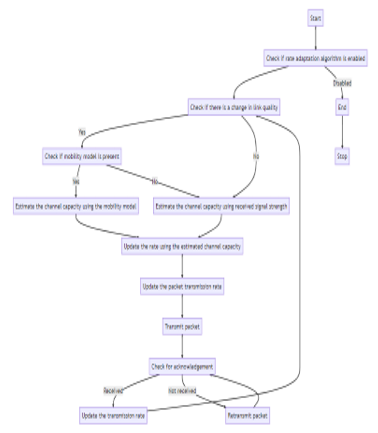A Performance Analysis of Rate Adaptation Algorithms in Wireless LANs Based on Mobility Models and Propagation Losses
Keywords:
Wireless local area network (WLAN), rate adaptation algorithm, propagation loss, NS-3, throughput, packet loss rate, delay, Wireless local area networks (WLANs), rate adaptation algorithms, mobility models, propagation losses, average throughputAbstract
Rate adaptation algorithms play a vital role in maintaining a high level of performance and reliable data transmission in wireless local area networks (WLANs) by determining the transmission rate for data packets. Using two mobility models and considering three propagation loss methods, this paper seeks to evaluate the performance of rate adaptation algorithms in WLANs by comparing four different rate adaptation algorithms utilizing the NS3 network simulator, which includes basic as well as advanced methods incorporating Signal to Noise Ratio (SNR) and Received Signal Strength Indicator (RSSI). Considering the mean values of throughput rates, delay times and packet losses , it is safe to say that based on received signals' strengths' indications along with ratio information; adapting its own transmission speed seems to be relatively more efficient. The examination conducted in this analysis helps expand our understanding on how different conditions such as mobility and propagation loss can impact rate adaptation algorithms' efficacy in WLANs, but on the other hand there are some issues unresolved such as taking into account additional parameters and various possible scenarios as well as dealing with the pitfalls of simulation-based approaches. In any case, this study lays down the groundwork for upcoming studies regarding rate adaptation methods implemented within wireless local area networks, and by implementing these findings one can improve both design and operational aspects of WLANs across a range of scenarios.
Downloads
References
Pasha, M. J., Pingili, M., Sreenivasulu, K., Bhavsingh, M., Saheb, S. I., & Saleh, A. (2022). Bug2 algorithm-based data fusion using mobile element for IoT-enabled wireless sensor networks. Measurement: Sensors, 24, 100548.
Prakash, P. S., Janardhan, M., Sreenivasulu, K., Saheb, S. I., Neeha, S., & Bhavsingh, M. (2022). Mixed Linear Programming for Charging Vehicle Scheduling in Large-Scale Rechargeable WSNs. Journal of Sensors, 2022.
C.V.Anchugam, K.Thangadurai (2017). “Link quality based Ant based Routing Algorithm (LARA) in MANET. International Journal Of Computer Engineering In Research Trends, 4(1):52-60
A Damayanthi, Mohammad Riyaz Belgaum, (2022). A Study of Heterogeneity Characteristics over Wireless Sensor Networks . International Journal Of Computer Engineering In Research Trends, 9(12):258-262.
P. Divyaja,M. Kalpana Devi,M. Usha Rani (2022). Secure Smart bed on villages for monitoring and storing patient records on Cloud using IoT with Android Mobile. International Journal of Computer Engineering In Research Trends .9(1).16-20.
Zekri, A., & Jia, W. (2020). Performance evaluation of rate adaptation algorithms for seamless heterogeneous vehicular communications. Peer-to-Peer Networking and Applications, 14, 1-17.
Kanda, T., Koda, Y., Kihira, Y., Yamamoto, K., & Nishio, T. (2022). ACK-Less Rate Adaptation Using Distributional Reinforcement Learning for Reliable IEEE 802.11bc Broadcast WLANs. IEEE Access, 10, 58858-58868.
Li, L. (2012). Using Multiple Metrics for Rate Adaptation Algorithms in IEEE 802 . 11 WLANs.
Hsu, W., Merchant, K., Shu, H., Hsu, C., & Helmy, A.G. (2004). Preference-based mobility model and the case for congestion relief in WLANs using ad hoc networks. IEEE 60th Vehicular Technology Conference, 2004. VTC2004-Fall. 2004, 4, 2962-2966 Vol. 4.
Feukeu, E.A., Djouani, K.D., & Kurien, A.M. (2011). Using a Greedy Algorithm for Link Adaptation in MIMO Wireless Networks. IEEE Africon '11, 1-7.
Li, L., Fan, Z., & Kaleshi, D. (2012). Using multiple metrics for rate adaptation algorithms in IEEE 802.11 WLANs. 2012 IEEE Wireless Communications and Networking Conference (WCNC), 2807-2812.
Rizal, S., Nugroho, D.A., Kim, S., & Kim, D. (2015). Rate adaptation algorithm for multicast communication in tactical networks. MILCOM 2015 - 2015 IEEE Military Communications Conference, 109-114.
Huang, J., Liu, W., Su, Y., & Wang, F. (2017). Multi-rate combination of partial information-based routing and adaptive modulation and coding for space deterministic delay/disruption tolerant networks. IET Commun., 11, 1365-1370.
Paris, S., Facchi, N., Gringoli, F., & Capone, A. (2013). An Innovative Rate Adaptation Algorithm for Multicast Transmissions in Wireless LANs. 2013 IEEE 77th Vehicular Technology Conference (VTC Spring), 1-5.
Chaab, W.A., Ismail, M., Altahrawi, M.A., Mahdi, H.F., & Ramli, N.B. (2017). Efficient rate adaptation algorithm in high-dense vehicular ad hoc network. 2017 IEEE 13th Malaysia International Conference on Communications (MICC), 23-28.

Downloads
Published
How to Cite
Issue
Section
License

This work is licensed under a Creative Commons Attribution-ShareAlike 4.0 International License.
All papers should be submitted electronically. All submitted manuscripts must be original work that is not under submission at another journal or under consideration for publication in another form, such as a monograph or chapter of a book. Authors of submitted papers are obligated not to submit their paper for publication elsewhere until an editorial decision is rendered on their submission. Further, authors of accepted papers are prohibited from publishing the results in other publications that appear before the paper is published in the Journal unless they receive approval for doing so from the Editor-In-Chief.
IJISAE open access articles are licensed under a Creative Commons Attribution-ShareAlike 4.0 International License. This license lets the audience to give appropriate credit, provide a link to the license, and indicate if changes were made and if they remix, transform, or build upon the material, they must distribute contributions under the same license as the original.





